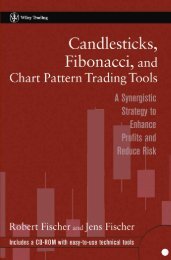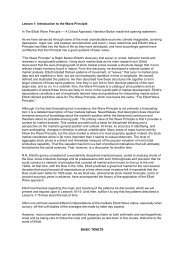The Ultimate Technical Analysis Handbook - Tradingportalen.com
The Ultimate Technical Analysis Handbook - Tradingportalen.com
The Ultimate Technical Analysis Handbook - Tradingportalen.com
You also want an ePaper? Increase the reach of your titles
YUMPU automatically turns print PDFs into web optimized ePapers that Google loves.
Chapter 8 — Head and Shoulders: An Old-School Approach<br />
Watching This Signal for a Reverse in Trend<br />
After years of chart-labeling and forecasting, I find myself be<strong>com</strong>ing an even bigger believer in the Wave<br />
Principle. Even so, while searching for the next big trading opportunity, I use everything from old-school<br />
technical analysis to <strong>com</strong>puterized trading systems of my own design. In the old-school area falls the Head<br />
and Shoulders pattern, which is a price pattern that often signals a reversal in trend.<br />
I don’t know who gets the credit for initially identifying the pattern, but its roots can easily be traced back to<br />
Charles H. Dow, Richard Schabacker, Robert D. Edwards and John Magee. <strong>The</strong> last two names on this list you<br />
might recognize as the Edwards and Magee who wrote what some consider to be the bible of technical analysis,<br />
<strong>Technical</strong> <strong>Analysis</strong> of Stock Trends. (First published in 1948, it’s a must-read for the serious technician.)<br />
So what exactly is a Head and Shoulders pattern? As you can see in Figure 75, it is a price pattern consisting of<br />
three up-and-down moves that make up the Left Shoulder, the Head and the Right Shoulder. <strong>The</strong> initial price<br />
move up is called the Left Shoulder, after which a small correction unfolds and introduces an even higher price<br />
high, called the Head. Following the secondary price peak, prices decline and then rally without achieving a new<br />
price extreme to <strong>com</strong>plete the Right Shoulder. It’s uncanny how similar, both in duration and extent, the Left<br />
and Right Shoulders often appear. Once the Right Shoulder has finally formed, a trendline can be drawn connecting<br />
the initial reaction low with the one following the formation of the Head – aptly called the Neckline.<br />
Figure 75<br />
<strong>The</strong> <strong>Ultimate</strong> <strong>Technical</strong> <strong>Analysis</strong> <strong>Handbook</strong> — © 2009 Elliott Wave International<br />
This ebook includes handpicked lessons from more than 200 pages of EWI’s <strong>com</strong>prehensive<br />
Trader’s Classroom Collection of eBooks. Learn more here: http://www.elliottwave.<strong>com</strong>/wave/ClubTCC<br />
47





